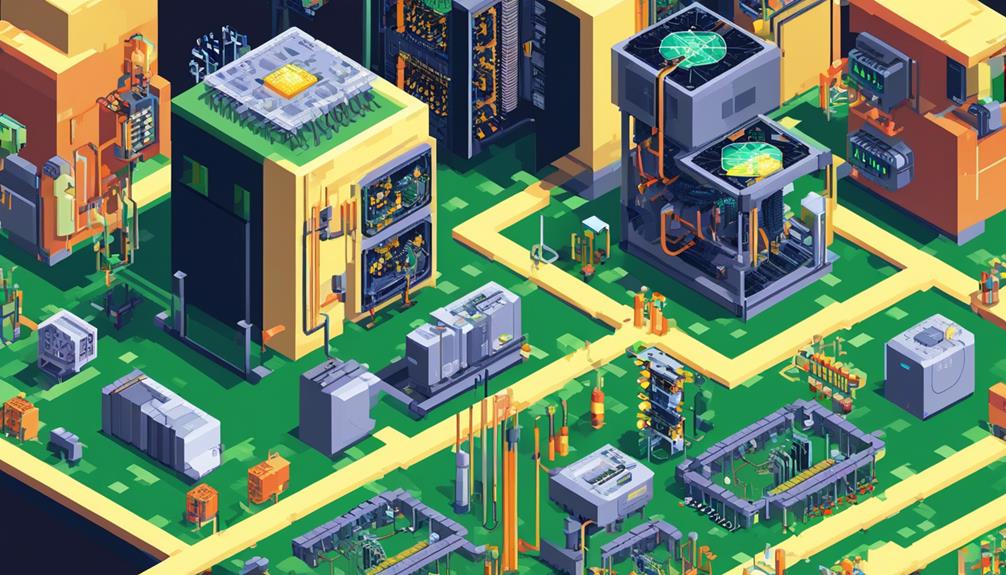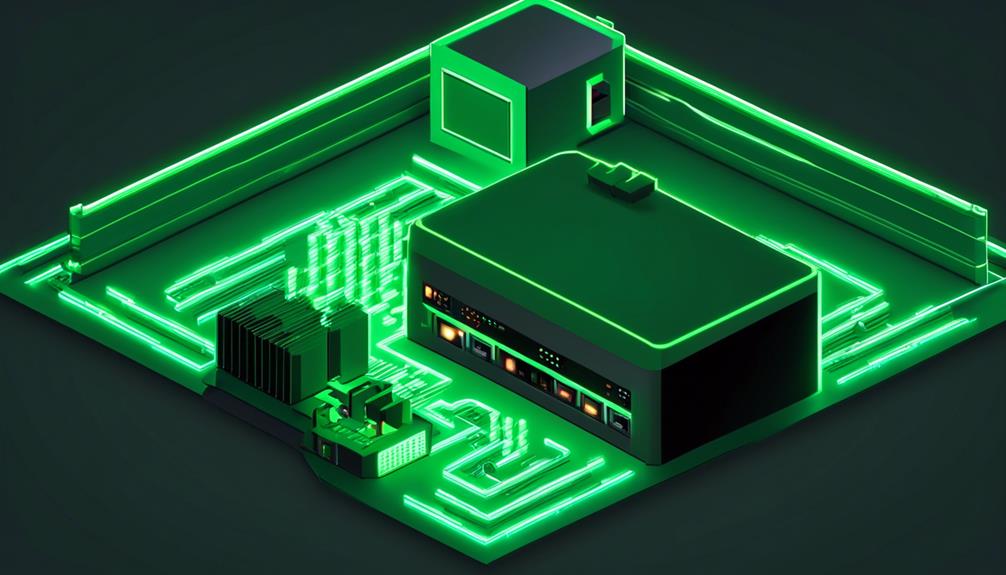In today's increasingly connected world, the demand for network hardware continues to rise. However, with this increased demand comes the need for more energy to power these devices. This is where energy-efficient network hardware comes into play.
By utilizing advanced technologies and design techniques, these devices are able to deliver the same level of performance while consuming less energy. But what exactly makes network hardware energy-efficient? How does it work? And what benefits can businesses and individuals derive from implementing such solutions?
In this discussion, we will explore the intricacies of energy-efficient network hardware, uncover its advantages, and delve into the best practices for reducing power consumption in network infrastructures. So, let's dive in and discover how energy efficiency can revolutionize the way we connect and communicate.
Key Takeaways
- Energy-efficient network hardware reduces energy consumption and costs.
- ENERGY STAR certification ensures energy efficiency and use of efficient components.
- Energy-efficient Ethernet solutions focus on reducing power consumption during low data activity.
- Using energy-efficient network hardware minimizes environmental impact and helps conserve power.
Why Choose Energy-Efficient Network Hardware?

Energy-efficient network hardware is an essential choice for organizations seeking to reduce energy consumption and costs while maintaining high-performance networking capabilities. By opting for energy-efficient network equipment, organizations can significantly reduce power consumption and minimize their carbon footprint. The benefits of choosing energy-efficient network hardware are numerous and can have a substantial impact on energy usage.
One key advantage of energy-efficient network hardware is its ability to conserve power when not in use. These devices are designed to minimize energy consumption during periods of low data activity, such as Low-power idle (LPI) requests and Green Ethernet technology. This reduction in power consumption can lead to significant cost savings for organizations, especially in large-scale network deployments.
Additionally, energy-efficient network hardware is easily identifiable through the ENERGY STAR label. The ENERGY STAR Product Finder allows organizations to filter for specific attributes and third-party certifications, ensuring that they make informed purchasing decisions. The ENERGY STAR label guarantees energy efficiency and the use of efficient components in the networking equipment, further contributing to reduced power consumption.
Choosing energy-efficient network hardware, such as routers and modems with low-power mode and Energy-Efficient Ethernet (EEE), can also improve overall network performance. These devices are designed to optimize power usage without compromising on network speed or reliability. By reducing power consumption, organizations can allocate resources more efficiently and potentially extend the lifespan of their network equipment.
Benefits of ENERGY STAR Certified Equipment
ENERGY STAR certified equipment offers several benefits, including cost savings, environmental impact, and performance optimization.
By choosing ENERGY STAR certified networking equipment, businesses can reduce energy consumption and lower their operating costs. This not only leads to financial savings but also helps to minimize the environmental impact by reducing the demand on energy resources.
Additionally, ENERGY STAR certified equipment is designed to deliver optimal performance, ensuring efficient and reliable network operations for businesses.
Cost Savings
Using ENERGY STAR certified equipment provides significant cost savings through improved energy efficiency. Here are some benefits of using energy efficient network hardware:
- Easy access to efficient equipment: The ENERGY STAR Product Finder allows users to filter network equipment by specific attributes, making it easier to find models that meet energy efficiency standards.
- Third-party certification: ENERGY STAR certification ensures that networking equipment meets energy efficiency requirements and uses efficient components. This certification guarantees that the equipment will operate efficiently and save energy.
- Informed purchasing decisions: The ENERGY STAR label helps users make informed decisions when purchasing networking equipment. By choosing certified products, users can ensure cost savings through reduced energy consumption and lower energy costs for homes, offices, and data centers.
Environmental Impact
The use of ENERGY STAR certified equipment offers significant environmental benefits due to its improved energy efficiency. By reducing energy consumption, these certified devices help minimize the environmental impact associated with network hardware. ENERGY STAR certification ensures that networking equipment meets specific energy efficiency standards and uses efficient components. This certification allows users to easily identify and select energy-efficient models through the Product Finder tool. Additionally, ENERGY STAR provides resources for energy efficiency in data centers, which can result in both energy and cost savings. Incorporating technologies such as Energy-Efficient Ethernet and Green Ethernet further reduce power consumption and contribute to a greener environment. By choosing ENERGY STAR certified equipment, users can help mitigate the environmental impact of their network infrastructure while enjoying the benefits of energy efficiency.
| Environmental Benefits of ENERGY STAR Certified Equipment | Facts |
|---|---|
| Easy access to efficient equipment through Product Finder | Certification ensures energy efficiency and use of efficient components |
| Informed purchasing decisions with ENERGY STAR label | Resources available for energy efficiency in data centers |
| Significant energy and cost savings in homes, offices, and data centers | Energy-Efficient Ethernet and Green Ethernet technologies reduce power consumption |
Performance Optimization
With the environmental impact of network hardware addressed, the discussion now turns to the benefits of ENERGY STAR certified equipment in optimizing performance.
- ENERGY STAR Product Finder provides easy access to efficient network equipment, allowing users to filter models by specific attributes and classification, ensuring energy efficiency and use of efficient components.
- Third-party certification ensures ENERGY STAR certified networking equipment helps in making informed purchasing decisions, while also offering resources for energy efficiency in data centers.
- ENERGY STAR certified networking equipment can potentially save significant energy costs, with Energy-Efficient Ethernet reducing power consumption during periods of low data activity.
These energy-saving features, such as Green Ethernet technology and low-power mode capabilities, allow the equipment to adjust power usage based on usage and cable length, resulting in up to 80% power savings.
This optimization not only reduces energy consumption but also enhances the overall performance of the network. By incorporating ENERGY STAR certified equipment, organizations can ensure efficient and high-performing networks while minimizing their environmental impact.
Product Finder for Energy-Efficient Network Hardware
The Product Finder for Energy-Efficient Network Hardware facilitates the search for certified models, aiding in the identification of energy-saving networking equipment. With the increasing emphasis on energy efficiency in the IT industry, it has become crucial for organizations to invest in energy-efficient network hardware. The ENERGY STAR Product Finder provides an easy and convenient way to access efficient network equipment by allowing users to filter models based on specific attributes.
By leveraging third-party certification, the ENERGY STAR label ensures that the network hardware meets stringent energy efficiency requirements. This certification guarantees the use of efficient components and adherence to energy-saving practices. These certified models not only help in reducing energy consumption but also contribute to cost savings in the long run.
The ENERGY STAR Product Finder allows users to explore a wide range of certified models, making it easier to find energy-efficient network equipment that meets their specific needs. This tool provides valuable information about the energy efficiency performance of different models, enabling organizations to make informed purchasing decisions.
In addition to the Product Finder, ENERGY STAR also offers resources for energy efficiency in data centers. These resources provide further insights and information on energy-saving practices and technologies. By leveraging these resources, organizations can optimize their data centers for energy efficiency and reduce their environmental footprint.
Furthermore, the ENERGY STAR Rebate Finder helps in finding available rebates for energy-efficient network equipment. This feature makes it easier for organizations to save on costs while investing in energy-efficient solutions.
Rebate Finder for Energy-Efficient Network Hardware

The Rebate Finder tool allows users to quickly and easily locate utility, state, and local rebates applicable to energy-efficient network hardware based on their location. By simply entering their zip code, users can access a comprehensive database of available rebates for energy-efficient network equipment. This tool is designed to assist individuals and organizations in identifying and accessing potential rebates for energy-efficient network hardware.
Benefits of using the Rebate Finder tool include:
- Efficiency: Users can save time and effort by using the Rebate Finder tool to quickly locate applicable rebates in their area. Instead of manually searching through multiple sources, the tool provides a centralized platform for finding available rebates.
- Cost savings: Energy-efficient network hardware can help reduce energy consumption and lower utility bills. By taking advantage of rebates offered by utility companies, states, and local governments, users can further offset the cost of purchasing and installing energy-efficient network equipment.
- Environmental impact: Investing in energy-efficient network hardware not only benefits users financially but also contributes to sustainability efforts. By reducing energy consumption, these devices help to minimize greenhouse gas emissions and conserve valuable resources.
Energy-Efficient Options for Large Network Equipment
Energy-efficient options for large network equipment encompass various technologies and certifications that ensure optimal energy efficiency and performance. The ENERGY STAR Product Finder is a useful tool for identifying efficient network equipment, allowing users to filter models based on specific attributes. Third-party certification is crucial in verifying the energy efficiency and use of efficient components for ENERGY STAR labeled products.
The ENERGY STAR label serves as a reliable guide for making informed purchasing decisions for large network equipment. It signifies that the equipment has met stringent energy efficiency standards set by the Environmental Protection Agency (EPA). By choosing ENERGY STAR certified products, organizations can reduce their energy consumption and lower their carbon footprint.
Two technologies that offer potential energy cost savings for network equipment are Energy-Efficient Ethernet (EEE) and Green Ethernet. EEE reduces power consumption during periods of low network activity by automatically adjusting the link speed and putting idle ports into sleep or standby mode. Green Ethernet, on the other hand, incorporates various power-saving features such as adjusting the link speed and turning off unused ports.
ENERGY STAR certification for large network equipment includes specific requirements such as efficient power supplies, real-time reporting, and active state data reporting. Efficient power supplies help minimize energy wastage by converting electricity more efficiently. Real-time reporting enables organizations to monitor and analyze energy usage, identifying areas for further optimization. Active state data reporting provides valuable information on the energy consumption of the equipment during different operational states.
Exploring Energy-Efficient Ethernet Solutions

When it comes to exploring energy-efficient Ethernet solutions, there are several key points to consider.
Firstly, power-saving network technologies play a crucial role in reducing energy consumption during periods of low data activity.
Secondly, energy-efficient transmission protocols, such as the 802.3az standard, enable ports to power down into standby mode when devices are inactive, further contributing to energy savings.
Lastly, implementing a green network infrastructure that prioritizes energy efficiency can have a significant impact on reducing overall energy usage in small network equipment.
Power-Saving Network Technologies
Exploring the potential of Energy-Efficient Ethernet solutions, this subtopic delves into power-saving network technologies. To reduce power consumption and improve energy efficiency in network hardware, several power-saving technologies have been developed. These include:
- Energy-Efficient Ethernet (EEE): This technology reduces power consumption during low data activity by using low-power idle requests to put transmitters into sleep mode. By minimizing power usage during periods of inactivity, EEE can significantly reduce energy consumption in network devices.
- Green Ethernet: Green Ethernet technology, including the 802.3az standard, allows ports to power down into standby mode when devices are inactive. This feature can potentially save up to 80% in power usage, resulting in substantial energy efficiency improvements.
- ENERGY STAR: The ENERGY STAR program offers resources for energy efficiency in data centers and provides easy access to efficient network equipment through its Product Finder. By using energy-efficient routers, modems, and other network devices, significant reductions in energy consumption can be achieved.
These power-saving network technologies not only contribute to reducing energy consumption but also result in cost savings, estimated at $450 million annually. By embracing these solutions, homes, offices, and data centers can enhance their energy efficiency and contribute to a more sustainable future.
Energy-Efficient Transmission Protocols
To further enhance energy efficiency in network hardware, the focus now shifts towards energy-efficient transmission protocols, specifically exploring the potential of Energy-Efficient Ethernet (EEE) solutions. EEE reduces energy waste by decreasing power consumption during periods of low data activity. One of the technologies that enable this is Green Ethernet, which includes the 802.3az standard. With Green Ethernet, ports can power down into standby mode when devices are inactive, resulting in potential power savings of up to 80%. Additionally, EEE scales network power consumption based on usage, automatically powering down routers and modems when not in use. By choosing ENERGY STAR-rated routers that adhere to IEEE standards, significant energy savings can be achieved. In fact, implementing EEE can lead to annual energy cost savings of up to $450 million in the US alone, primarily in homes and offices.
| Transmission Protocol | Key Features | Potential Benefits |
|---|---|---|
| Energy-Efficient Ethernet | Reduces power consumption during low data activity | Decreased energy waste |
| Green Ethernet (802.3az) | Ports power down into standby mode when inactive | Potential power savings of up to 80% |
| Scaling Power Consumption | Routers and modems automatically power down | Energy savings when devices are not in use |
| ENERGY STAR-rated routers | Adherence to IEEE standards | Significant impact on total energy usage |
Green Network Infrastructure
Energy-efficient network infrastructure can be achieved through the implementation of Energy-Efficient Ethernet (EEE) solutions. These solutions aim to reduce power consumption during low data activity periods, resulting in significant energy savings.
Green Ethernet technology, such as the 802.3az standard, can save up to 80% in power usage. Additionally, energy-efficient small network equipment conserves power when not in use, contributing to a reduction in energy demand. Choosing routers and modems with low-power mode (LPM) can also have a significant impact on total energy usage.
Furthermore, efficient power supplies with specific power factor criteria are essential for ENERGY STAR certification of large network equipment. By incorporating these energy-efficient measures, organizations can create a green network infrastructure and reduce their environmental footprint while optimizing energy usage.
Potential Savings With Energy-Efficient Network Hardware

The potential for significant savings in energy costs can be achieved through the use of energy-efficient network hardware. According to research conducted by the Lawrence Berkeley Laboratory, the implementation of Energy-Efficient Ethernet (EEE) has the potential to save up to $450 million annually in energy costs in the United States alone. These savings would be distributed across various sectors, with homes and offices accounting for the majority. Homes could save approximately $200 million, while offices could save $170 million. Data centers, which are notorious for their high energy consumption, could potentially save $80 million.
The savings can be attributed to the reduction in network power consumption achieved through the adoption of energy-efficient network hardware. In 2005, network interface controllers in the US consumed a substantial amount of electricity, totaling 5.3 terawatt-hours. By implementing energy-efficient network hardware, this power consumption can be significantly reduced, resulting in substantial cost savings.
Energy-Efficient Ethernet is a technology that optimizes network power consumption by dynamically adjusting the power usage based on the network traffic load. It achieves this by intelligently switching to lower power modes during periods of low activity and quickly returning to full power when needed. This approach ensures that network devices consume only the necessary amount of energy, reducing wastage and overall energy costs.
The estimated savings highlight the significant impact that energy-efficient network hardware can have on reducing energy consumption and associated costs. As organizations and individuals strive for sustainability and cost-efficiency, investing in energy-efficient network hardware becomes a practical choice. The potential savings are substantial and underscore the importance of adopting energy-efficient practices in the networking industry.
Understanding Green Ethernet Concepts
Green Ethernet concepts are essential for enhancing energy efficiency, promoting sustainability, and improving overall performance in network hardware. Understanding these concepts is crucial for reducing energy usage, improving network efficiency, and achieving cost savings.
Here are three key points to consider:
- Energy-Efficient Ethernet: This concept focuses on reducing power consumption during periods of low data activity. It achieves this by employing techniques such as low-power idle requests and maintaining link signaling integrity. By scaling network power consumption based on usage, Energy-Efficient Ethernet automatically powers down when not in use, potentially saving significant energy costs.
- 802.3az Standard: Green Ethernet technology incorporates the 802.3az standard, which enables ports to power down into standby mode when devices are inactive. Additionally, this standard adjusts power based on the length of the cable, further optimizing energy usage. By implementing the 802.3az standard, network hardware can save up to 80% in power usage, making it a vital component for energy efficiency.
- Improved Performance: Green Ethernet concepts not only contribute to energy efficiency but also enhance overall performance. By reducing alien crosstalk, which is interference between cables, network hardware can operate more efficiently and reliably. This improvement in performance translates to better network speeds, reduced latency, and improved user experience.
Related Products for Energy-Efficient Networking

One important consideration when seeking to optimize energy usage and improve network performance is exploring the range of related products available for energy-efficient networking. The ENERGY STAR Product Finder is a useful tool that provides easy access to efficient network equipment with specific attributes for filtering models. This allows users to find the most energy-efficient options for their specific needs.
Third-party certification is another key factor in ensuring energy efficiency in network equipment. ENERGY STAR labeled networking equipment undergoes rigorous testing and certification processes to ensure that they meet strict energy efficiency standards. This certification guarantees the use of efficient components and overall energy savings.
In addition to certification, it is important to consider available rebates for energy-efficient networking equipment. The Rebate Finder tool helps users find available rebates at utility, state, and local levels. These rebates can significantly offset the initial cost of purchasing energy-efficient network hardware, making it a more cost-effective choice in the long run.
Technologies such as Energy-Efficient Ethernet and Green Ethernet are specifically designed to reduce power consumption and improve overall performance. Energy-Efficient Ethernet reduces power consumption during periods of low network activity, while Green Ethernet optimizes power usage by automatically detecting cable length and adjusting power accordingly. By implementing these technologies, network administrators can further enhance energy efficiency while maintaining high-performance levels.
Choosing energy-efficient network equipment not only reduces energy consumption but also has a positive impact on the environment by reducing the demand on energy resources. By considering energy-efficient products, organizations can make significant strides towards minimizing their carbon footprint and promoting sustainability in the IT industry.
Introduction to Energy-Efficient Small Network Equipment
Energy-efficient small network equipment is essential for conserving power and reducing energy costs in networks. These devices, such as routers and modems, are designed with energy-saving features to minimize power consumption when not in use.
Energy-Saving Features
Introduction to Energy-Saving Features in Small Network Equipment
Energy-saving features are an essential aspect of energy-efficient network hardware. These features not only contribute to reducing electricity consumption but also help businesses save on energy costs.
Here are three key energy-saving features to consider when choosing small network equipment:
- Power Management: Many energy-efficient network devices come equipped with power management features that allow them to automatically adjust power consumption based on network activity. This ensures that energy is only used when necessary, resulting in significant energy savings.
- Sleep Mode: Sleep mode is another energy-saving feature that allows network devices to enter a low-power state when not in use. By automatically powering down or reducing power consumption during periods of inactivity, network equipment can conserve energy without impacting performance.
- Energy Star Certification: Energy Star certification is a third-party validation that ensures the energy efficiency of network equipment. By choosing Energy Star certified products, businesses can be confident that they are investing in energy-efficient hardware that meets strict energy-saving standards.
Cost-Effective Solutions
Energy-saving features provide multiple benefits, such as reducing electricity consumption and offering cost-effective solutions for energy-efficient small network equipment.
The ENERGY STAR Product Finder is a valuable resource that allows easy access to energy-efficient network equipment with specific attributes and third-party certification.
The Rebate Finder is another helpful tool that can assist in identifying available rebates for energy-efficient network equipment. These rebates can help reduce the initial cost of investment.
Energy-Efficient Ethernet and Green Ethernet technologies are cost-effective solutions that not only save significant energy costs but also improve overall performance.
Choosing ENERGY STAR-certified routers and modems can have a substantial impact on total energy usage, making a positive environmental contribution.
Using energy-efficient small network equipment can significantly reduce the demand on energy resources and save energy on Wi-Fi. This can result in long-term cost savings for organizations.
How Energy-Efficient Small Network Equipment Works

Small network equipment that is designed to conserve power, such as routers, modems, and wireless connectivity devices, operates efficiently even when not in use. This type of equipment consumes the same amount of energy whether active or not, according to the California Energy Commission.
To better understand how energy-efficient small network equipment works, consider the following:
- Low-Power Mode (LPM): Energy-efficient routers and modems can feature LPM, which reduces energy consumption. These devices spend approximately 80% of their time in LPM, resulting in significant power savings.
- Energy-Efficient Ethernet (EEE): EEE is a technology that scales network power consumption based on usage. It allows devices to enter a low-power state when there is little or no network traffic, further reducing energy consumption.
- ENERGY STAR®-rated routers: These routers adhere to IEEE standards and are certified by ENERGY STAR®, a program backed by the U.S. Environmental Protection Agency. ENERGY STAR®-rated routers are designed to be energy-efficient, making them desirable for small business technology upgrades.
As the number of network-enabled devices continues to grow, the demand for energy-efficient network hardware becomes increasingly important. By 2020, an estimated 50 billion network-enabled devices worldwide will consume 1,140 terawatt hours per year, as projected by the International Energy Agency.
Choosing energy-efficient small network equipment not only contributes to reducing energy consumption but also helps businesses save on power costs in the long run. With features such as Low-Power Mode and Energy-Efficient Ethernet, small network equipment can operate efficiently and effectively while minimizing its environmental impact.
Choosing the Right Router for Energy Efficiency
To ensure optimal energy efficiency in a network setup, selecting the appropriate router is crucial. By choosing the right router, it is possible to reduce power consumption and save energy. There are several factors to consider when selecting a router for energy efficiency.
One important feature to look for in a router is low-power mode (LPM) capabilities or energy-efficient Ethernet (EEE) connectivity. These features allow the router to operate in a power-saving mode when there is little or no network traffic, reducing energy consumption. Additionally, routers that are ENERGY STAR®-rated have been certified to meet energy efficiency standards set by the International Electrotechnical Commission (IEC) and can provide significant energy savings.
To make informed purchasing decisions, it is recommended to use Energy.gov's appliance energy calculator to determine the energy consumption of different router models. This tool allows users to compare the energy usage of various routers and choose the most energy-efficient option.
Another important consideration is to turn off routers when they are not in use. This simple step can significantly reduce power consumption. Additionally, replacing old routers with more energy-efficient models can lead to substantial power savings over time.
In order to balance the lifespan of a router with advances in technology and connectivity, it is important to consider the reliability and security of wired versus wireless routers. While wireless routers offer convenience and flexibility, they generally consume more power than wired routers. Therefore, it is important to weigh the benefits and drawbacks of each option and choose the one that best suits the specific network setup.
Best Practices to Reduce Network Power Consumption

Implementing effective strategies to minimize power consumption in a network setup is essential for achieving energy efficiency and reducing costs. By following best practices, organizations can significantly reduce their network's power consumption and contribute to a more sustainable future.
Here are three key practices to consider:
- Choose energy-efficient network equipment: When selecting routers, switches, and other network devices, look for models that are ENERGY STAR certified. The ENERGY STAR Product Finder can help filter equipment based on specific attributes such as product type and classification. Additionally, explore utility, state, and local rebates through the Rebate Finder to take advantage of potential cost savings.
- Utilize Energy-Efficient Ethernet (EEE): Energy-Efficient Ethernet is a technology that reduces power consumption during periods of low data activity. By implementing EEE, network devices can automatically adjust their power usage, resulting in significant energy savings. In the United States alone, EEE has the potential to save up to $450 million a year in energy costs.
- Leverage Green Ethernet technology: Green Ethernet, including the 802.3az standard, can further reduce power usage by up to 80% and adjust power based on cable length. This technology intelligently manages power consumption, ensuring that network devices operate efficiently while minimizing unnecessary energy usage.
To further reduce network power consumption, consider using routers and modems with low-power mode (LPM) capabilities or energy-efficient Ethernet (EEE) connectivity. These features enable devices to enter a low-power state when not in use, resulting in significant energy savings.
Frequently Asked Questions
What Is Energy Efficiency in Networking?
Energy efficiency in networking refers to the implementation of technologies and practices that minimize power consumption and maximize performance.
It involves the use of energy-efficient routers and other network equipment, which reduce power usage during low data activity and adjust power levels based on cable length.
By adopting energy-efficient networking solutions, organizations can benefit from reduced energy consumption, lower operating costs, and a smaller carbon footprint.
Proper equipment selection and consideration of ENERGY STAR-rated options are crucial in achieving energy efficiency in networking.
What Does Energy Efficient Ethernet Do?
Energy Efficient Ethernet is a technology that reduces power consumption in network devices during periods of low data activity. It achieves this by putting transmitters into sleep mode when no data is being sent, resulting in lower energy usage.
This technology also allows ports to power down into standby mode when devices are not active, and it adjusts power used for transmission based on cable length, resulting in significant energy savings benefits of up to 80%.
Additionally, it improves overall performance by reducing alien crosstalk and scaling power consumption based on usage.
What Is the Difference Between EEE and Green Ethernet?
The main difference between EEE and Green Ethernet lies in their approach to reducing power consumption in network hardware.
EEE focuses on putting transmitters into sleep mode during periods of low data activity, while Green Ethernet adjusts power usage based on cable length.
Both technologies offer significant energy savings and can improve network performance.
EEE has the potential to save up to $450 million annually in energy costs, while Green Ethernet switches can achieve up to 80% power usage reduction.
What Is Energy Efficient Equipment?
Energy efficient equipment refers to hardware designed to minimize energy consumption while maximizing performance. It includes devices that carry the ENERGY STAR label, indicating third-party certification of energy efficiency and use of efficient components.
Energy saving technology, such as Low-power Idle (LPI) requests and Green Ethernet, reduces power consumption during periods of low data activity.
The benefits of energy efficient equipment are significant, as they can save energy and costs, particularly in data centers, homes, and offices.
